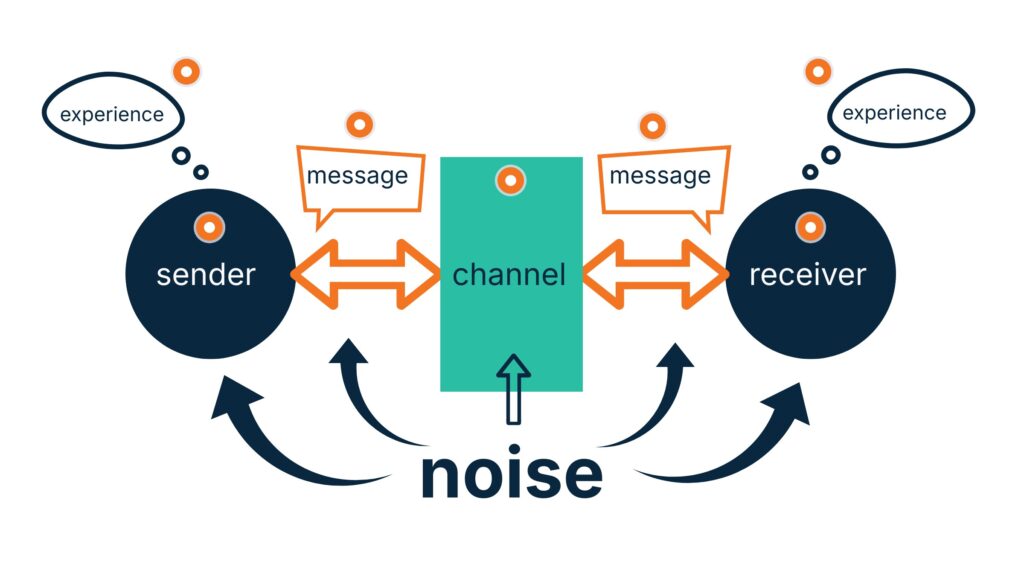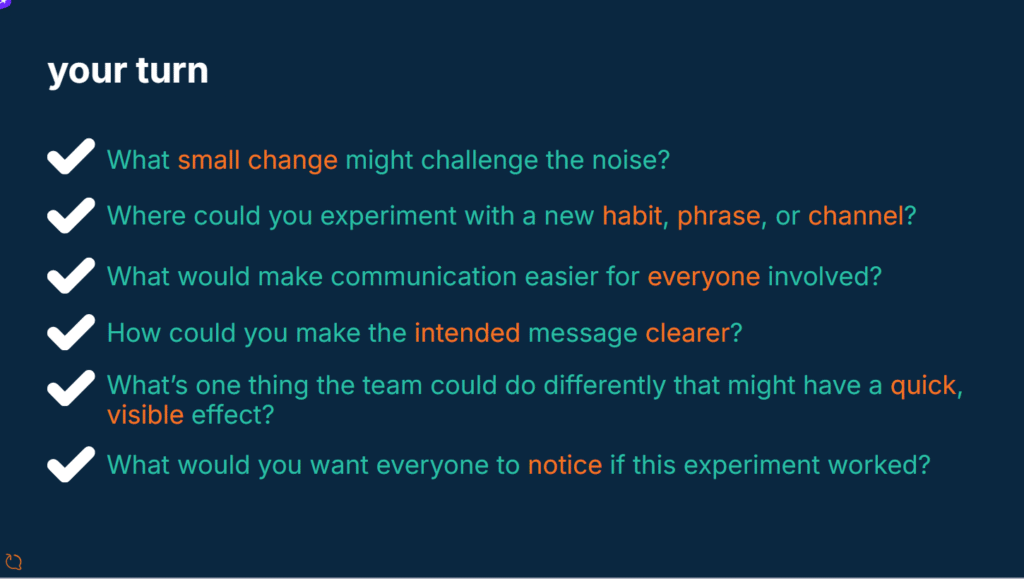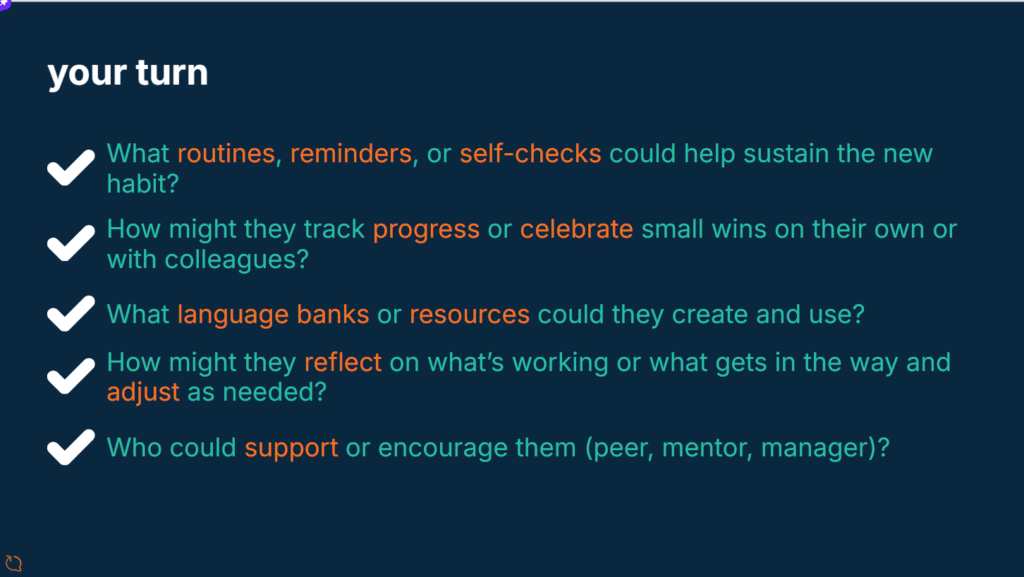Clear communication goes beyond perfect grammar: it means cutting through noise and confusion. Vicky Margari reveals how hidden issues like fear, habits, and digital overload can cloud understanding. She offers practical tools and small steps to help teams build lasting habits for better communication.
What if training wasn’t the same as transformation?
So many clients start with “I want to improve my grammar”.
I used to ask all the classic questions:
Why do you want to improve your English? What do you need to do with it?
Then I would tell my clients how to negotiate, run meetings, write emails. I would tell them how to use the present perfect and the conditionals. I would give them the phrasal verbs and all the good stuff. They would do well in sessions. Then they’d slip right back into old habits at work.
I kept wondering: am I not giving enough practice? Am I not explaining things well? Why isn’t this creating the change my clients hope to see and pay for? What if training wasn’t the same as real transformation? What was my value as a trainer?
Clear communication in teams: a multi-faceted challenge
It became clear that most communication problems at work aren’t only about language. There is so much more:
- misunderstandings
- assumptions
- digital overload
- unhelpful habits
Sometimes it’s the channel (Teams chat, email, Slack, etc.).
Often, it’s the story we keep telling ourselves (“I’m bad at this.” “They’ll think I’m stupid.”).
Perhaps even good old resistance to change.
I call all these barriers noise. And if I wanted real change in communication, I needed to find and cut the noise, not just teach the rules. I needed to sit down with my clients and look together at the whole communication ecosystem.
Visualise the noise
I use a simple model to help my clients see the noise. It is a basic map, inspired by communication theories and models, such as the Shannon-Weaver Communication Cycle model. It shows the sender, message, receiver, channel, and feedback loop. Noise can be anywhere: vague messages, cultural misunderstandings, the wrong channel or just digital clutter.
Find the noise: curiosity before solutions
When a client said “I want to improve my grammar,” I used to jump straight to solutions. Now, I slow down and ask:
• What does grammar mean for you in this case?
• What do you think happens when you make a mistake? Is that true? What else might be true?
• What would be different for you if you felt more confident? What would confidence look like for you in meetings/emails/Slack?
The answers go deeper than tenses or phrasal verbs. Maybe it’s fear of being judged, confusion about what’s expected, or not knowing how to use email and chat effectively. By asking, not assuming, we can spot the real noise.
💡 Tip: Before offering solutions, ask more questions. Then ask some more. Keep digging. You may find the biggest problem isn’t what the client said it was.
For more on coaching questions and practices, visit the ICF World Coaching blog.
Challenge the noise: small experiments, big impact
A tech team I worked with struggled with digital communication. Their team chat was full of short, unclear messages (“done”, “any update?”). Decisions got buried and nobody knew who was doing what, or where information could be found (spoiler: everywhere, all at once). They thought their English was the problem but what they really needed was clarity and shared habits.
After we found the noise, we picked one practical experiment for each type:
• Vague messages: write clear, specific updates, for example “draft sent to Anna yesterday – waiting for edits”.
• Missing owner/action: add who/what/when to every message, for example “Tom to send report by Friday EOD”.
• Buried decisions: summarise and pin key decisions in chat; log into a shared decisions doc.
• Overuse of chat: move detailed info to email/project board; use chat for brief checks/reminders.
It wasn’t that grammar or vocabulary didn’t matter. Of course, they did. But using simple, practical phrases in context helped the team communicate with more confidence and focus.
Sometimes, the smallest change (a new phrase, a summary, a clear owner) done together makes the biggest difference. Small changes give quick wins and build trust that more is possible.
💡 Tip: Pick one visible, practical habit to challenge the noise. Small, specific changes beat grand solutions.
Tame the noise: sustaining change
Change doesn’t stick on its own. Habits return, and noise creeps back in when everyone gets busy. Real transformation happens when clients, teams and individuals, own the process for themselves.
Here’s how my tech client’s team made their new habits stick:
• Self-regulation: we designed individual checklists that everyone could keep handy and use.
• Accountability: peer reminders became normal. If someone slipped back, a colleague would gently nudge “Can we clarify who’s doing what?”
• Resources: a shared phrase bank made it easy to grab and adapt useful action statements and decision summaries.
• Reflection: they set aside 10 minutes each Friday for a team check: “What’s helping? Where are we slipping? What can we do better next week?”
• Celebration: whenever things went well with fewer follow-ups and less stress, they shared these small wins in the chat.
These routines, owned by the team, not me, made the changes feel natural. The new habits stuck. So did the confidence.
💡 Tip: For lasting change, help clients build routines for self-regulation, accountability, resources, reflection and celebration.
Final thoughts on clear communication for teams
I started out hoping for more. More impact, more real-world communication, more clients who felt like themselves at work in any language. Hope is not a strategy. But it can be the reason to take that first, small step toward real change.
If you want to help your clients cut the noise, start with curiosity. Try a small experiment. Help the client and team find the systems that make it stick.
***
If you enjoyed this read, you might also be interested in the following articles:
A helpful mindset for business English users

Vicky Margari
Vicky Margari helps teams and professionals turn digital communication into real connection. She designs practical training solutions for virtual teams. Connect with her on LinkedIn.









